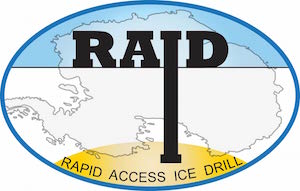First, we got to tour the Matrix design and production facilities, where they turn raw steel tubing into finely machined parts for the drilling industry. Matrix employs highly skilled machinists and welders, and they’re also using robotic tools more and more.
Next, we checked out the new gear. During our field trials in Antarctica, we found that some off-the-shelf parts more commonly used on commercial drilling platforms are over-engineered for RAID. We don’t have the benefit of support vehicles, cranes, and shackles, so everything must be moved around and installed by hand. Some parts are simply too heavy and too cumbersome. So, we re-designed key components like the fluid diverter and swivel to get the job done and to be lightweight for more nimble handling.

AJ checks out the new diverter and likes what he sees. It’s a fraction of the size and weight of our original unit. Plus, it’s much easier to install and service.

Our new custom swivel, which threads onto the drill string and routes fluid to the fluid separation system while the drill is turning. This design has an improved flow path and is optimized for light weight.
One of the key components needing some attention is our screen shaker, used for initial separation of ice cuttings from drilling fluid. In our Antarctic field trials, we had problems getting the shaker to work as expected, at least partly due to the warm conditions at Minna Bluff and the tendency for the fine mesh screens to clog up with re-frozen water ice. We also wanted to improve the way fluid moved through the shaker box, how we control the shaker’s eccentric movements, and how screens are held in the unit. All of this required some physical tests, but how do we do that in the relatively warm climate of Tennessee?
The answer is to rent a large walk-in ‘reefer’ (freezer) and move the shaker. That required doing some electrical work, setting up a closed-loop circulation system with pumps and large temporary tanks, buying a large tote of Estisol, making ice shavings, and getting everything cold. Our lead engineers for the shaker tests, Steve and Kira, were very creative and able to get as close as possible to real-world test conditions with a freezer temperature of about -15°F.

Steve explains the modifications they’ve made to the shaker unit as we get ready for the first test.

This is what we like to see — fairly dry, cakey cuttings falling off the edge of the screens into the melting tank below. The goal is to get as much fluid to pass through the screens and go back into circulation without overloading the melting tank.

Steve, Thor and Jeff watch intently as the next slug of fluid and ice cuttings come across the screens.
In between runs with the shaker, we went over designs for other pieces of equipment and looked at progress inside the FRS. It was fun to see the FRS parked on the grass outside past stacks of metal tubing waiting to be processed.
The Matrix team has contributed a lot to the RAID project. Not only are they talented engineers and mechanical designers, but their fabrication finish is of high quality. For us, however, as an experimental R&D project, they really excel at listening to our input, coming up with unique designs, staying flexible, and showing a willingness to experiment with and analyze the results of testing. They don’t shy away from unexpected or poor results, but rather look for new ways to tackle a problem. Kudos to Matrix!
With completion of the shaker tests, we can start putting all the various components back into place. Next come some modifications to the Estisol supply tanks and hose routings, as well as study of the glycol loop that provides heat to the melting tank. More to come!
Photos by John Goodge.
The views expressed here are personal reflections that do not represent either the RAID project or the National Science Foundation.






